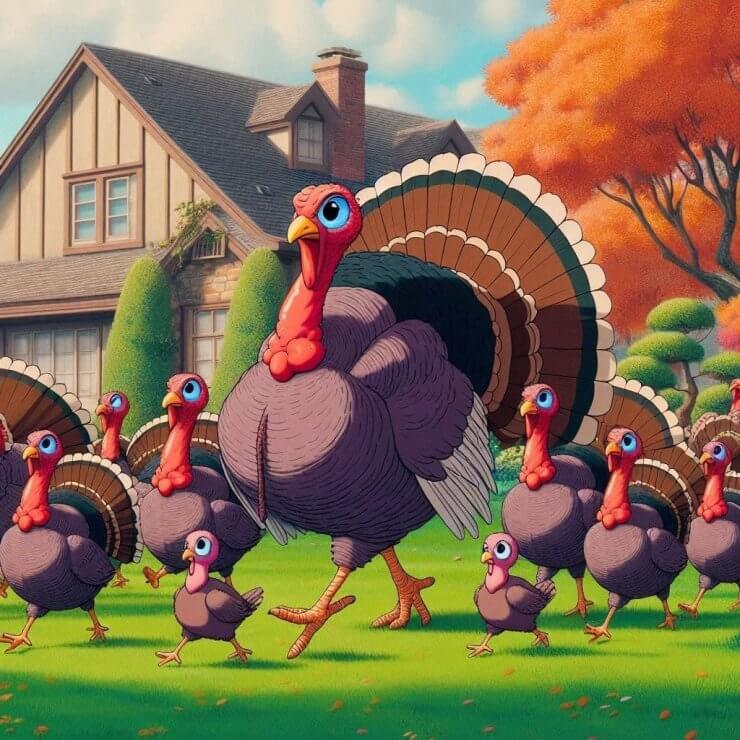Read by Michael Flamel

From my desk, I can see the entire backyard and the slough beyond it. Every day, just around noon, a family of wild turkeys embarks on a slow march across the yard, exploring the folds and furrows of the lawn in search of their daily feast.
The Turkey Trot: A Daily Routine
They always cross the yard in search of food, whether or not they found any the day before. This charming avian family never ventures alone, always moving as a collective unit. Startled by a coyote or my clumsy attempts at trash disposal, one vigilant turkey is all it takes to alert the entire group. The hens encircle the younger turkeys, imparting wisdom and managing threats for the benefit of the fledglings.
The Oddities of Turkey Life
The turkeys never take a day off, maintaining an intimate two-foot proximity between each member. They exclusively approach the lawn from the south, hinting at a rhythmic daily circuit. Always a perfect ten in number, this turkey family seems to have an unspoken pact to maintain their ideal group size.
Feasting or Foraging? Unveiling the Turkey’s Menu
Curiosity led me to the lawn to discover what culinary delights awaited the turkeys. Alas, I found nothing for myself, yet these tenacious birds seem to unearth enough sustenance to bring them back daily, like clockwork, around noon. Surveying the landscape, I noticed distant trees to the north, potential entrances to the forest where they might nest and hide.
Daytime Visionaries and Nighttime Flyers
With a newfound appreciation, I learned that turkeys possess excellent daytime vision but are virtually blind at night. To outsmart nocturnal predators, they take to the trees at night, showcasing another hidden talent – turkeys can fly, even though they generally prefer a leisurely stroll.
Comparing the Wild and the Domesticated
While our Thanksgiving tables are adorned with plump, domesticated turkeys, the wild counterparts are a spectacle of natural grace. Unlike their farm-raised relatives, these untamed turkeys lead a life of perpetual motion, their daily march a testament to their survival instincts and tight-knit social structure.
The contrast is stark – where farmed turkeys are bred for size and tenderness, their wild counterparts exhibit agility and adaptability. The wild turkeys’ keen sense of danger, honed through generations of living in the wild, stands in contrast to the sheltered existence of their domesticated relatives.
Thanksgiving Tale: From Forests to Feasts
As we gather around our Thanksgiving tables, it’s worth pondering the journey of these wild turkeys, whose ancestors once roamed freely across the American landscape. The domesticated turkey, plucked and served as the centerpiece of our feast, represents a far cry from the robust and self-sufficient wild turkeys forging a daily path through my backyard.
What Wild Turkeys See
I stood, thus, on the grass, attempting to understand the turkeys. I even looked up at the window where I stood every day to spy at them. But, of course, I couldn’t see myself. All I saw was the sky reflected back to me from the glass. Which is, I suppose, what they see when they lift their turkey eyes each day and wonder whose house they pass as they lunch. ❖
About the Author: Zary Fekete grew up in Hungary. He has a debut novella (Words on the Page) out with DarkWinter Lit Press and a short story collection (To Accept the Things I Cannot Change: Writing My Way Out of Addition) out with Creative Texts. He enjoys books, podcasts, and many many many films. Twitter and Instagram: @ZaryFekete


 Previous
Previous

